|
NOT much remains of the Junior Astronomical Association other than entries on the memorial websites for Marion (Eadie) Turner and Harry Turner, and what is to be found in the pages of Urania, the JAA journal, and letters passed between Marion and Harry in the 1930s and early 1940s. There is also the newspaper cutting shown below:

cutting found in Urania for October 1936; must be from a Glasgow newspaper
(no date or newspaper name on it) as MFE's address is given as just Dundas Street
THE CUTTING indicates that the JAA was founded in Glasgow in 1933 by Marion Eadie, then 15, and friends of hers with a common interest in astronomy under the patronage of the prominent physicist, astronomer, mathematician and academic Sir James Jeans.
Harry Turner recalled in May 1976:
"In the beginning was the Junior Astronomical Association, founded in the mid-thirties. Marion was the Branch Secretary of the Glasgow branch of the British Astronomical Association for several years before the war.
"Around 1937/8 the JAA formed an astronautical section, under pressure from Arthur Clarke and other members. I was a member of the Manchester Interplanetary Socieity at this time and became involved with the JAA as a result. Later, I helped out as cover designer for Urania, the JAA journal, and as treasurer."

J.A.A. letterhead, 1938
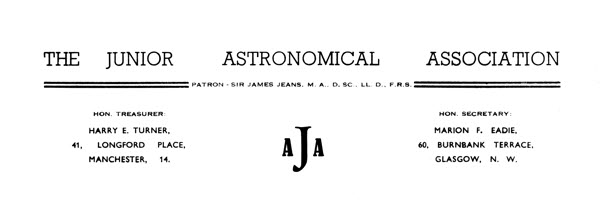
J.A.A. letterhead, 1939
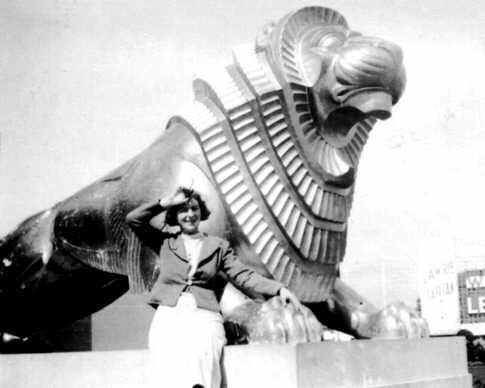
Harry Turner's first meeting with Marion Eadie was
at the 1938 Empire Exhibition in Glasgow
Urania first appeared in 1935 and ran from April of that year to November of 1941. By then, the world was at war again and that meant shorages of materials for creating small press magazines and male members being called up for military service—into the RAF in the case of members Harry Turner and Arthur Clarke.
There were two distinct series of the magazine, 70 issues of which are to be found in the Turner family's archives. Series 1 comprised the 12 issues of volume one and the first 6 issues of volume two. The pages were created by folding 10" x 8" in half to create a booklet of two dozen 5" x 8" pages, which were stapled into a double weight card cover to created a 5⅛" x 8¼" booklet.
Series 2 consisted of 8" x 10" pages stapled with a cover of thinner, grey paper of size 8 5/16" x 8¼." printed with the title, a graphic, the society's motto, etc. From January 1940 on, the cover acquired more ambitious designs created by Harry Turner and incorporating the relevant Zodiac symbol. (see below)
SERIES 1 of Urania has a surprisingly sophisticated initial structure, the Turners' son Philip found when preparing this page. Rather than of a dozen 5" x 8" sheets stapled inside the card cover, there are half a dozen 10" x 8" sheets printed as a booklet within the cover. This means that the first sheet was printed with pages 24 and 1 on the outer side and pages 2 and 23 on the reverse, sheet two had pages 22 and 3 on one side and pages 4 and 21 on the reverse; and so on towards the centre.
Marion's son, Philip, observed:
"When I decided to create a hardback edition of some short stories in 1993, using a newly acquired PC and a laser printer, I had to create the volume as a set of six files, each containing 32 pages of the text.
"I then had to write two macros; one to insert page numbers (which would not change when the order of the pages was changed), and another to sort the pages into the right order for printing one side and then the other on 8 sheets of A4. The end product of my printing campaign was a set of six booklets, which could be sewn together and glued in to a hard case to complete the book.
"It wasn't until the WordPerfect company, assisted by frequent bug reports from me, had hoiked them out of its 'print as booklet' option in version 6.2 for DOS, some 60 years after the JAA started producing Urania, that life got a whole lot easier for artisan desktop publishers."
Latter issues of the magazine were produced as sets of 5" x 8" pages stapled together inside the card cover when the amount of content for a particular issue made that the easier production option.
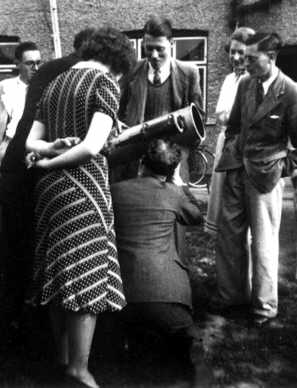
At a prewar BAA get-together, Marion is at the back, on the right. Joyce Fairbairn, (in the stripy dress), who later married SF fan and author Sam Youd (a.k.a. John Christopher and a host of other names), is in the foreground
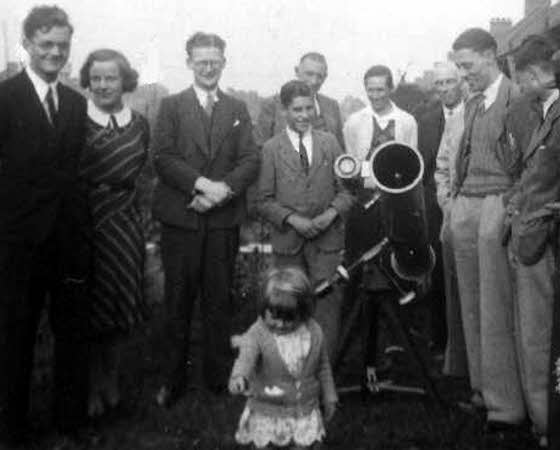
Arthur Clarke (third from left) was also at the meeting of members of the British Astronomical Association and the Junior Astronomical Association
THE JAA was mainly astronomy based-but it acquired an Astronatics Section following lobbying by rocketry enthusiasts such as Arthur C. Clarke in London and members of the Manchester Interplanetary Society, including Harry Turner and Eric Burgess, all of whom contributed articles to the Association's journal. (see below)
Here is Volume 1, Number 1
RESCUE MISSION: Open some of the covers of Series 1 of Urania and you can find yourself looking at what could be blank sheets of paper. That's what can happen with old documents printed using dyes instead of good old pigments like carbon black.
It's a case of into the scanner with the 'blank pages' and then fingers crossed that your graphics program can tweak the pale grey shadows into something an OCR program can tackle; or, failing that, something the good old Mark 1 human eyeball can read.
Here are 'almost facsimile' PDF editions of the two issues which were worst affected:
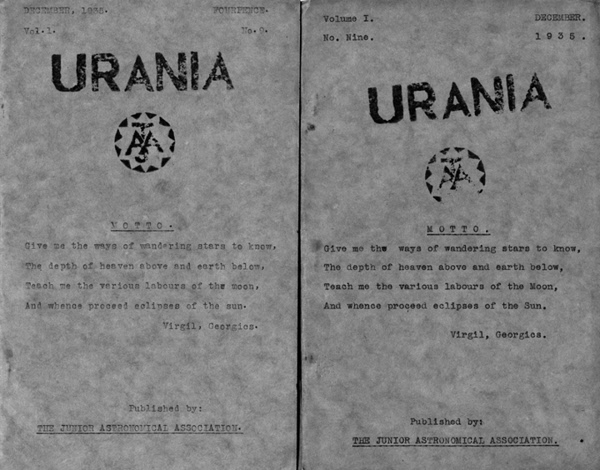
Spot the Difference: hand made covers for Urania, December 1935 issue
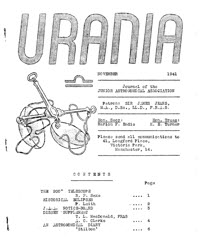
Urania for November 1941
| This appears to be the final issue of the magazine. It includes a feature on the 1940 Walt Disney film Fantasia and Arthur C. Clarke's recollections of the "Rite of Spring" sequence. P.H.T. |
THE JAA folded due to lack of funds and general problems of operating in wartime, but its expertise was not lost.
Harry Turner recalled in May 1976:
"In the early 1950s, Marion was contacted by Eric W. Turner of Basingstoke (no relation!) who was endeavouring to form a junior astronomical society and had been informed by someone in the BAA of Marion's earlier venture. So far as one can establish, his Junior Astronomical Society officially came into existence in 1953. Marion was on the Council, attended several meetings and typed stencils for the early journals, and generally helped to get things moving.
"The first AGM was held in Chester on April 24th 1954, by which time Patrick Moore had moved in on the act, Dr. J.G. Porter had become patron of the Society and there was a move to up-market the homely duplicated journal into a pseudo-BAA type journal. Eric Turner relinquished the Presidency to Ernest Noon, and became secretary.
"I don't think I was involved with the JAS, apart possibly from helping out with some of the stencils for the journals—I have vague memories of a character called 'JASper' that Eric Turner introduced as a decoration on the pages."
IN DUE COURSE, the JAS morphed into the Society for Popular Astronomy, which continues to exist at the time of writing. |











